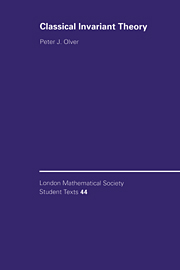Book contents
- Frontmatter
- Contents
- Introduction
- 1 Prelude — Quadratic Polynomials and Quadratic Forms
- 2 Basic Invariant Theory for Binary Forms
- 3 Groups and Transformations
- 4 Representations and Invariants
- 5 Transvectants
- 6 Symbolic Methods
- 7 Graphical Methods
- 8 Lie Groups and Moving Frames
- 9 Infinitesimal Methods
- 10 Multivariate Polynomials
- References
- Author Index
- Subiect Index
2 - Basic Invariant Theory for Binary Forms
Published online by Cambridge University Press: 08 January 2010
- Frontmatter
- Contents
- Introduction
- 1 Prelude — Quadratic Polynomials and Quadratic Forms
- 2 Basic Invariant Theory for Binary Forms
- 3 Groups and Transformations
- 4 Representations and Invariants
- 5 Transvectants
- 6 Symbolic Methods
- 7 Graphical Methods
- 8 Lie Groups and Moving Frames
- 9 Infinitesimal Methods
- 10 Multivariate Polynomials
- References
- Author Index
- Subiect Index
Summary
Using the previous chapter as our motivational springboard, let us now dive into our chosen subject. Most of the classical literature, and indeed most of the present text, is devoted to the simplest case — that of a binary form or homogeneous polynomial in two variables, along with the inhomogeneous univariate counterpart. In this chapter, we shall introduce many of the fundamental concepts in the invariant theory of binary forms. The ideas will be illustrated by the next two most important cases — that of cubic and quartic polynomials. In each case, we shall exhibit a complete system of invariants, as well as a complete list of canonical forms. These examples will serve to motivate the general definitions of invariants and covariants. The emphasis here is on important particular examples, such as Hessians, resultants, and discriminants, and their role in the classification and geometry of binary forms. These initial constructions bring the basic problem of classifying the invariants into focus, leading to the fundamental Basis Theorem of Hilbert, whose proof will appear in Chapter 9. The chapter concludes with a brief discussion of the algebraic relationships, known as “syzygies”, that exist among the fundamental invariants and covariants.
Binary Forms
In the classical literature, homogeneous polynomials are called forms. The adjectives “binary”, “ternary”, and so on refer to the number of variables that the form depends on.
- Type
- Chapter
- Information
- Classical Invariant Theory , pp. 11 - 43Publisher: Cambridge University PressPrint publication year: 1999



